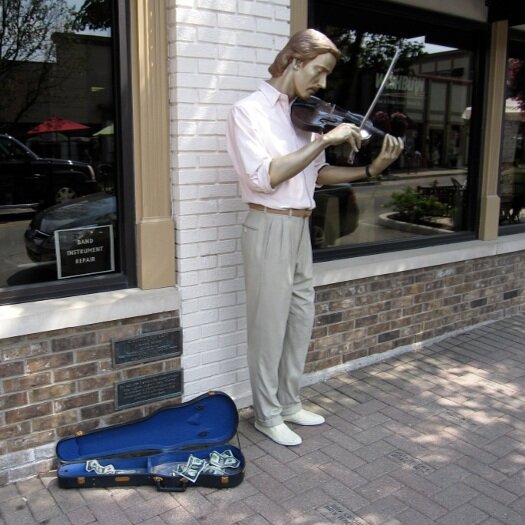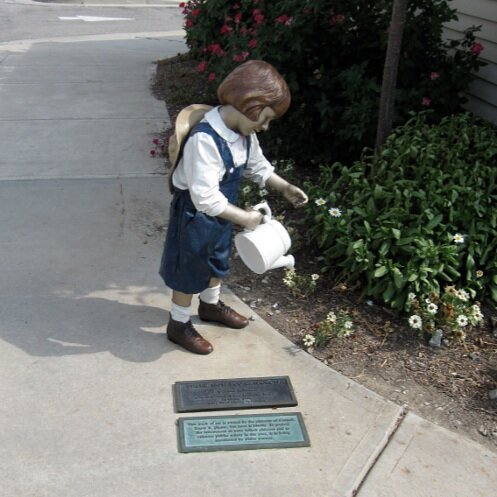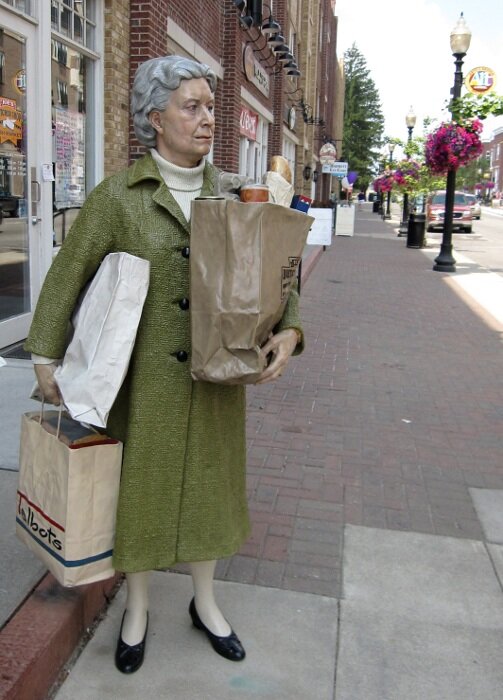More Public Sculptures: Carmel Misses the Point about Equity Altogether
Many readers will not recognize the name of J. Seward Johnson, but they’ll recognize his artwork. Johnson is the creator of hundreds of painted bronze figures, which populate airports, corporate buildings, and the streets of small cities across the United States. For the most part, the sculptures represent white middle-class Americans doing everyday activities—talking on the phone, crossing the street, reading a newspaper. The stories they tell don’t do much more than hint at a simplistic version of America, of good people from small towns. If the writers of Leave It to Beaver or Father Knows Best were sculptors, these would be the sculptures that they would create.
Carmel, Indiana and its mayor Jim Brainard have a particular penchant for Johnson’s work. Fifteen of his sculptures dot the city’s landscape as if to evoke this particular form of Americana, to symbolize the city’s imagined wholesomeness. These bronzes are so insistent in their messaging that they soon become horrifying—a monstrous simulacrum of suburbia.
The aesthetic value of Johnson’s sculptures is questionable. The curator and critic Dr. Sam Hunter once called Johnson’s work “the worst sort of kitsch.” Critic Robert Hughes described his sculptures as “chocolate-box rubbish.”
To me, his work is middlebrow at best, reactionary at worst. I simply can’t agree with Joyce Carol Oates that Johnson’s works echo Walt Whitman in their evocation of “egalitarian American democracy.” These are everyman and everywoman with a saccharine sentimentality. They are not America singing or a body electric. They are stock characters from a catalogue for corporate executives who neither take the time to understand art nor consult with those who do. They are a symptom of late capitalism in which the rich pay a tithe for their wealth through public statements of solidarity with working folks, even as they strip away opportunity and the social safety net. When placed in public spaces, these sculptures become the physical manifestation of these statements—condescending nods to the quotidian lives of struggling families. It’s a play at populism that’s as empty as the faux-gold plated glamour of Trump Tower.
In Carmel, these public statements are paid with public funds to the tune of about $100K per sculpture. Though, as I understand it, there’s a discount for bulk orders.
In recent months, the mayor and city council of Carmel have come under criticism for its sculpture program. The group Carmel Against Racial Injustice (CARI) has taken the city to task for an expensive program that has next-to-zero representation of BIPOC residents. The exception is Seward Johnson’s ‘Beautiful Riff,” a sculpture group commemorating Louis Armstrong, Sidney Bechet, and Jack Teagarden. In response to these critiques, the Mayor decided to commission yet another Seward Johnson sculpture of a Black girl playing at a stop sign: “Waiting to Cross,” which was first cast in 1986. Additionally, he has proposed to work with the Indian community to design an artwork that represents an Indian woman in traditional dress.
This is the city’s concession to diversity in its public art program: another $70K purchase from the Seward Johnson Atelier and a second $100K sculpture purchase from a yet-to-be-named artist. While the city says it has had hopes to do more, one of the biggest hurdles the city has faced, according Dan McFeely a spokesperson for the city, is that “There weren’t many statues (of minorities by Seward Johnson) available at the time [i.e. when Carmel’s sculpture program began]…It just wasn’t done.” Just because Seward Johnson’s art wasn’t concerned about the rich diversity of America, doesn’t mean that other artists weren’t. It doesn’t mean that there weren’t outstanding BIPOC artists who were producing much better work. What it does mean is that the leaders in Carmel simply weren’t concerned about these issues enough.
The statements from the City of Carmel suggest a fundamental problem in their understanding of diversity, equity, and inclusion. Equity is not simply about diverse representation in artists’ subjects; it’s about ensuring that BIPOC artists have the opportunity to create new artworks—especially those meant to symbolize their communities. On September 21, 2020, Ti'Gre McNear, the City Reform Chair of CARI argued this point to the city council: it should commission a Black artist for one of the new works.
Commissioning artwork is not simply a symbolic act, it is an economic act with real world consequences for those involved (and those not involved). Continuing to pay hundreds of thousands of dollars to the atelier of a deceased artist—one who grew up in the lap of privilege as an heir to the Johnson and Johnson fortune—speaks to a misunderstanding of the economics of public art. If the city funnels nearly all of its resources to white (male) artists as it has done over the past decade, then it is perpetuating the systematic racism (and gender disparity) of the art world. Carmel’s fifteen Seward Johnson sculptures cost well over $1 million. These funds, distributed more equitably, would not only ensure a less homogenous art landscape but would also circulate wealth more broadly in the art community, which has its own economic networks.
If the City of Carmel is sincere about a more representative and equitable public art program, then it needs to better understand the symbolic and the economic contexts in which public art programs operate—and the ways in which their own program reproduces real and symbolic economic, racial, and gender inequities.


